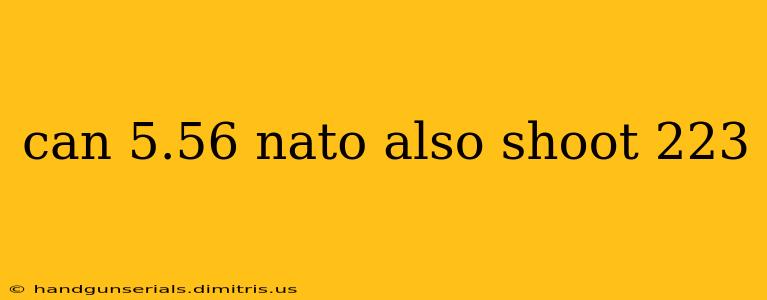Can 5.56 NATO Also Shoot .223 Remington? The Truth About Cartridge Compatibility
The question of whether a 5.56 NATO chamber can fire .223 Remington ammunition is a common one among firearms enthusiasts, and the short answer is: generally, yes, but with important caveats. This seemingly simple question delves into the nuanced world of cartridge dimensions, pressures, and potential risks. Understanding these differences is crucial for safe and responsible firearm handling.
Understanding the Differences: 5.56 NATO vs. .223 Remington
While visually similar, the 5.56x45mm NATO and the .223 Remington cartridges are not interchangeable without considering several key distinctions:
-
Chamber Dimensions: The 5.56 NATO chamber is slightly larger than the .223 Remington chamber. This difference is subtle but significant. The extra space in the 5.56 NATO chamber allows for slightly greater expansion of the cartridge case during firing, accommodating the higher pressures generated by 5.56 NATO ammunition.
-
Pressure: This is the most critical difference. 5.56 NATO ammunition operates at higher chamber pressures than .223 Remington ammunition. Firing 5.56 NATO in a .223 Remington chamber could lead to catastrophic failure, potentially causing serious injury or death.
-
Case Dimensions: While the overall cartridge length is similar, minor variations in case dimensions exist. These slight differences can affect the reliability and safety of firing one round in a chamber designed for the other.
Why the Confusion and Potential Danger?
The similarity in appearance often leads to confusion. However, the higher pressure of 5.56 NATO rounds presents a clear danger if fired in a firearm chambered only for .223 Remington. The .223 Remington chamber is not designed to handle the increased pressure, potentially resulting in:
- Overpressure: This can lead to the chamber stretching, bulging, or even rupturing.
- Bullet setback: The higher pressure could push the bullet back into the case, potentially causing malfunctions or misfires.
- Case head separation: The pressure could cause the base of the cartridge to separate, leading to catastrophic failure.
The General Rule and Important Exceptions
The widely accepted rule is: It's generally safe to fire .223 Remington in a 5.56 NATO chamber, but it's unsafe to fire 5.56 NATO in a .223 Remington chamber.
However, this is not a universally absolute rule. Some .223 Remington chambers may be tighter than others, potentially leading to increased pressure and risk even with .223 Remington ammunition. Similarly, some 5.56 NATO chambers may be more tightly toleranced than others, lessening the margin of safety.
Manufacturer Recommendations are Paramount
Always consult your firearm manufacturer's instructions for specific recommendations on ammunition compatibility. They will provide the most accurate and reliable information regarding the safe use of your firearm. Ignoring these recommendations could have severe consequences.
Conclusion: Prioritize Safety
Understanding the subtle yet crucial differences between 5.56 NATO and .223 Remington ammunition is paramount for responsible gun ownership. Prioritizing safety by carefully following manufacturer guidelines and understanding the potential risks associated with ammunition compatibility is crucial for preventing accidents and ensuring safe firearm handling. Always err on the side of caution.

